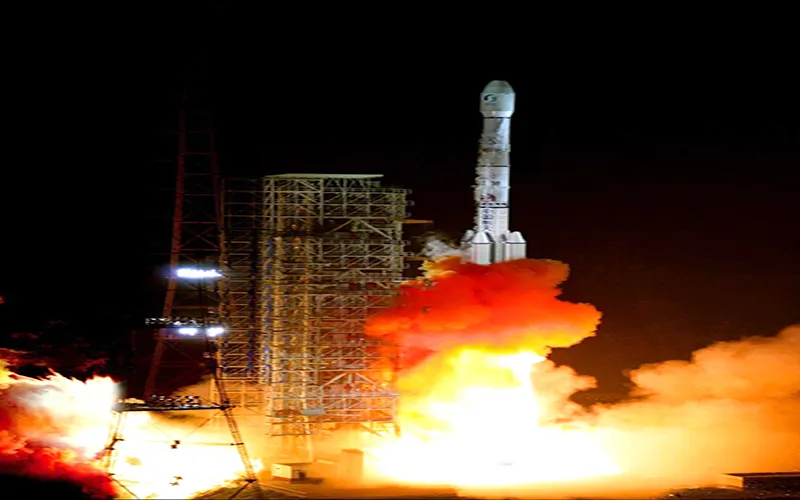Within the of a week last month, China has successfully carried out maiden launches of two of its next generation launch vehicles. Besides validating the rockets for future manned and unmanned space missions, they have also demonstrated China's strategic capabilities pertaining to outer space. An analysis using open sources reveals technical details of these launch vehicles, to the possible extent, as well as their inherent strategic advantages. It also raises pertinent questions regarding their deployment by China.
Technical specifications
On September 19, the Long March 6 (LM-6) successfully lifted off from the Taiyuan Satellite Launch Center. The LM-6 is 29.24 meters tall with a dry mass of 9,020 kilograms and launch weight of 103,217 kilograms. This three stage launch vehicle is capable of placing payloads up to 1080 kg into a 700 km sun-synchronous orbit. The first stage is powered by a single YF-100 semi-cryogenic engine using liquid oxygen and propellant grade kerosene RP-1. The validation of YF-100 advances the development of China's heaviest rocket Long March 5 to be debuted next year which uses a number of these engines at the core stage. The second stage is powered by a single YF-115 semi-cryogenic engine with re-ignition capability while the third stage uses four thrusters.
According to the designer-at-chief at the Shanghai Academy of Spaceflight Technology, the LM-6 is intended to enlarge China's share of the international space revenue in the booming micro-satellite sector. Indeed, the LM-6 placed twenty small satellites into orbit on its maiden launch. This launch vehicle also possesses the capability for providing rapid access to space. It is expectedly light weight, has high thrust semi-cryogenic engines and most importantly, has a turn-around period of just seven days. China could further reduce this turn-around for placing or replacing a satellite during an emergency.
The Long March 11 (LM-11) is launched on September 25 from the Jiquan Satellite Launch Center. The LM-11 is considered to be the solid propellant version of LM-6. It is an 18.7 meter tall vehicle with three solid fuel stages and an auxiliary liquid fuel stage. The first stage measuring nine meters long and two meters in diameter is supposedly the biggest solid fuel motor to be operated by China with the second stage measuring three meters long and two meters in diameter. The third stage is one meter in length and 1.4 meters in diameter. The fourth stage is powered by an YF-50 liquid engine providing insertion capability into a variety of orbits. The LM-11 can place 1,000 kilogram payload into a sun-synchronous orbit.
Three satellites Tianwang 1A, 1B and 1C launched by LM-11 will experiment new intersatellite communication architecture named GAMALINK developed by a Portuguese company Tekever. The company terms GAMALINK communication system as a part of infrastructure for creating an internet-like networking environment in space and an enabler for Shanghai Engineering Centre for Microsatellite, the lead project designer, to expand into global small satellite market. These three satellites and another small satellite also deployed by LM-11 will conduct a variety of communication, propulsion, Earth observation and solar science experiments. Despite the demonstrated civilian applications, the LM-11 is also another addition to China's rapid response capabilities as the deputy head of China Academy of Launch Vehicle Technology proclaimed LM-11 enhancing China's capability to rapidly enter space for meeting launches-on-demand in case of disasters and emergencies.
Strategic imperatives and concerns
The case of missing plane MH 370 revealed China's operational efficiency and future designs for swiftly acquiring ground situational awareness using space based assets. It was reported that China rapidly repositioned at least ten high resolution satellites to provide communications, weather monitoring and other search and rescue services for ground teams. In addition, reports suggested a frustrated China contemplating launching fifty satellites for the purpose of deploying a global surveillance constellation on par with the US. The solid fuelled rockets like the LM-11 provide faster rapid response capability compared to the liquid fuelled engines since the former is readily fuelled awaiting launch command. China is also weighing the security of its satellites as one of the factors for designing these quick launch vehicles.
The threat perception of space assets would rise sharply in the event of a military escalation along the Western Pacific, most probably due to a miscalculation between China and a perceived adversary like the US. China believes it can take asymmetric advantage of America's dependency on space assets for conducting military operations by denying such access using a variety of kinetic and non-kinetic anti-satellite (ASAT) weapons. China regularly tests such weaponry beginning with blinding US reconnaissance satellites using laser device in 2006, a destructive ASAT test in 2007 and subsequent missile defence tests in 2010 and 2013 analysts believe are disguised ASAT tests. As the US strives to maintain its space superiority, China invests in disruptive technologies yielding space denial capabilities.
However, with technological progress and growing demand to field robust communication, positioning and navigation, and Intelligence, Surveillance and Reconnaissance (ISR) infrastructure, China is also tempered to augment its satellite fleet. Its armed forces are also beginning to rely heavily on space assets as the military doctrine calls for winning local wars under conditions of informatization. For example, the credibility of anti-ship ballistic missile threat to American aircraft carriers is dependent on real time information being gathered by the Yaogan series of satellites scanning the Western Pacific. This is one scenario where it will be the turn of the US to play disruptive. The US with its lead in ASAT technologies can target these Yaogan satellites to disconnect the information link.
As a response to China's 2007 ASAT test, the US executed Operation Burnt Frost in 2008 where a Standard Missile-3 was launched from the guided missile cruiser USS Lake Erie that intercepted and destroyed USA-193 spacecraft belonging to the US National Reconnaissance Office at an altitude of 240 kilometers. Multiple cruisers each with multiple ASAT capable missiles in the inventory, the US can target a number of Chinese satellites simultaneously across the world. Concerned with this development, China is investing in rapid response space launch capabilities. It has already demonstrated such capability using solid fuelled Kuaizhou launch vehicle in recent years.
The LM-6 and LM-11 showcase improvements over Kuaizhou. First, China advanced semi-cryogenic engine technology for launches-on-demand. Although cryogenic engines employing liquid oxygen and liquid hydrogen as fuels produce high thrust per every kilogram of fuel consumed, condensation, storage and handling of these gases is a high risk and time consuming activity. With the introduction of semi-cryogenic engines that replaced liquid hydrogen with RP-1, the risks of handling, costs and environmental pollution were reduced. Second, the re-ignition capability of LM-6 allows placing satellites at various orbits and constellations.
Third, China designed a unique camouflaged transporter-erector-launcher (TEL) for LM-6. Providing mobility will allow LM-6 to be quickly transported to a desired launch location as well as defend it from being attacked as this vehicle makes good for a fleeting target. An over-ground launch container is designed for LM-11. China could advance this design to a TEL or take it underground into a silo for same strategic reasons. And fourth, both the launch vehicles can also be used in the offensive by launching tiny co-orbiting satellites acting as hunter-killers of an adversary's critical satellites.
However, the technical details brought forth the issue of successfully distinguishing spacecraft launches from a string of missile launches, especially if a canister or a silo is involved. In addition, the need to distinguish ASAT launches which China has earlier performed from its satellite launch centres further complicates the decision-making of its adversary. The emerging space cooperation between the US and China that also includes a dialogue on space security might help dissuade these concerns in the future.
Conclusion
The new launch vehicles have demonstrated advances in China's rapid response space launch capabilities. China's ambition to dominate outer space is influenced by history, technological advances and changes in the world order. The emphasis on attributing mobility to these vehicles and using multiple launch sites in quick succession for lifting satellites shows China's readiness to handle space warfare. China also used these launches as test bed for emerging small satellite technologies as well as proved the reliability of its launch industry to potential customers in this sector. This proves the dual-use nature of LM-6 and LM-11.
(The writer is a Research Assistant at Observer Research Foundation, Delhi)
The views expressed above belong to the author(s). ORF research and analyses now available on Telegram! Click here to access our curated content — blogs, longforms and interviews.




 PREV
PREV

